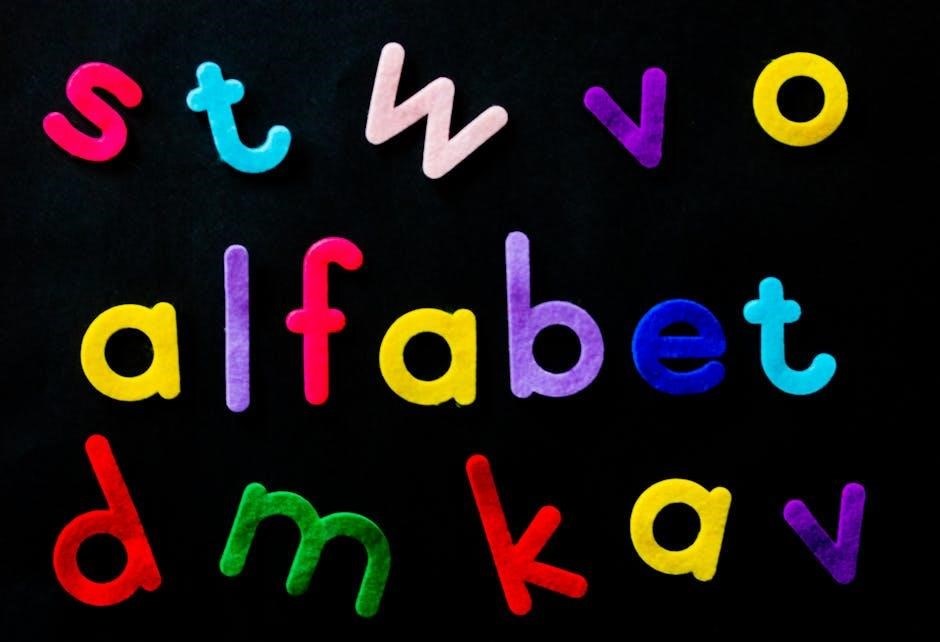Welcome to the world of French! Discover the richness of this Romance language, essential pronunciation tips, and basic concepts to build a strong foundation.
Overview of the French Language and Its Importance
French, a beautiful Romance language, is spoken by millions globally. It is an official language in several countries and international organizations, making it culturally and politically significant. Learning French opens doors to rich literature, art, and business opportunities. Its melodic pronunciation and nuanced grammar make it a rewarding language to master, enhancing both personal and professional growth.
Benefits of Learning French for Beginners
Learning French offers numerous benefits, from enhancing career opportunities in international organizations to enriching cultural experiences. It improves cognitive skills and opens doors to Francophone literature, cinema, and art. Speaking French also facilitates travel and communication in many countries, making it a valuable asset for personal and professional growth. It’s a rewarding journey that broadens your global perspective.

Basic Concepts of the French Language
French belongs to the Romance languages, derived from Latin, with distinct grammar, syntax, and pronunciation rules. Understanding these basics is key to mastering the language effectively.
French is a Romance language, evolving from Latin, the language of the Romans. It shares similarities with Spanish, Italian, and Portuguese, as all stem from Latin roots. French developed distinct pronunciation, grammar, and vocabulary over centuries, blending Latin with Germanic and Celtic influences. This linguistic heritage makes French a logical yet poetic language, appealing to learners worldwide.
History and Evolution of the French Language
French evolved from Latin, the language of the Romans, blending with Gaulish and Frankish influences. Over centuries, it developed into Old French during the Middle Ages, becoming the language of literature and royalty. By the Renaissance, Middle French emerged, and Modern French took shape in the 17th century. The French Academy standardized the language in 1635, preserving its rich linguistic heritage while adapting to cultural and historical changes.

Key Features of French Pronunciation and Grammar
French pronunciation is marked by unique sounds like the guttural “r” and nasal vowels. Accents alter meanings and pronunciation. Grammar involves gendered nouns, adjective placement, and complex verb conjugations, including irregular verbs. Sentence structure differs, with adjectives often following nouns. Punctuation and spelling rules, like spaces before colons and silent letters, add complexity. Mastery of these elements is essential for effective communication.

Pronunciation in French
Mastering French pronunciation involves unique sounds like nasal vowels and the guttural “r.” Understanding accents and difficult sounds is crucial for clear communication. Practice regularly for accuracy.
Understanding French Accents and Difficult Sounds
French pronunciation includes unique sounds like nasal vowels and the guttural “r.” Accents such as é, ù, and ç can change word meanings. Practice pronunciation tables to master these challenging sounds. Regular practice helps learners produce accurate and clear French speech, essential for effective communication.
Practical Tips for Mastering French Pronunciation
Use pronunciation guides and audio resources to mimic native speakers. Practice challenging sounds like nasal vowels and the guttural “r” daily. Break words into syllables and focus on intonation. Record yourself and compare with native speech. Consistency is key—dedicate time to practice, even for a few minutes each day. Consult textbooks or online courses for structured lessons.
The French Alphabet and Spelling
Master the French alphabet and its unique pronunciation using tables. Learn common spelling rules and exceptions. Practice regularly to build a solid foundation for reading and writing.
Learning the French Alphabet
Mastering the French alphabet is the first step in learning the language. It consists of 26 letters, similar to English, but with distinct pronunciation. Use pronunciation tables to practice sounds; Focus on accents like é, ù, and ç, which don’t exist in English. Regular practice helps build a solid foundation for reading and writing in French.
Common Spelling Rules and Exceptions
French spelling involves specific rules and exceptions. Silent letters, accents (é, ù, ç), and gender-specific endings can be tricky. For example, hôtel (hotel) and leçon (lesson) have silent ‘h’ and ‘c’. Pluralization often follows patterns, but exceptions exist, like cheval (horse) becoming chevaux. Understanding these rules aids in accurate writing and clear communication in French.
French Verbs and Conjugations
French verbs are categorized into regular, irregular, and reflexive verbs. Regular verbs follow predictable patterns, while irregular verbs require memorization. Mastering conjugations in various tenses is essential for clear communication in French, enabling learners to express actions accurately and confidently in different contexts.
French verbs are divided into regular and irregular categories. Regular verbs follow predictable conjugation patterns, while irregular verbs do not. Understanding these categories is crucial for mastering French conjugation. Regular verbs are grouped into three main types: -er, -ir, and -re verbs, each with distinct endings. Irregular verbs, like être and avoir, must be memorized as they don’t follow set rules. This foundation is vital for constructing accurate sentences in French.
Understanding Verb Tenses in French
French verb tenses indicate the time at which an action occurs. Common tenses include present (e.g., je parle), imperfect (e.g., je parlais), future (e.g., je parlerai), and conditional (e.g., je parlerais). Each tense has specific conjugation rules and usage. Mastering these tenses is essential for clear and effective communication in French, allowing learners to express actions in different time contexts accurately.

Subject Pronouns and Sentence Structure
Mastering subject pronouns (je, tu, il, elle, nous, vous, ils, elles) and sentence structure is crucial. French typically follows a Subject-Verb-Object word order, making communication clear and precise.
Understanding Subject Pronouns in French

Subject pronouns in French are essential for sentence formation. Common pronouns include je (I), tu (you), il (he), elle (she), nous (we), vous (you plural), ils (they masculine), and elles (they feminine). They replace nouns in sentences, making communication clearer. In French, the sentence structure often follows a Subject-Verb-Object order, similar to English, but with unique rules for pronoun usage and placement.
Basic Sentence Structure and Word Order
In French, the basic sentence structure follows a Subject-Verb-Object (SVO) pattern, similar to English. However, French often places adjectives after nouns and uses specific word order rules for questions and negative sentences. For example, questions can be formed by inverting the subject and verb or using question words like qui (who) or quoi (what). Negative sentences typically use ne before the verb and an adverb like pas after it, e.g., Je ne mange pas (I don’t eat).
Definite and Indefinite Articles in French
Definite articles (le, la, les) specify particular nouns, while indefinite articles (un, une, des) refer to non-specific ones. They indicate gender, number, and specificity, guiding clear communication.
Using Definite Articles (le, la, les)
Definite articles le, la, les are used to specify particular nouns. Le and la correspond to gender, while les is plural. For example, le livre (the book), la maison (the house), les enfants (the children). They precede nouns and agree with gender and number, helping clarify meaning in sentences.
Understanding Indefinite Articles (un, une)
Indefinite articles un (a) and une (a) are used for non-specific nouns. Un precedes masculine nouns, while une precedes feminine nouns. For example, un livre (a book) and une maison (a house). They help indicate that the noun referred to is general, not specific, making sentences clear and precise in communication.

Basic Vocabulary for Everyday Situations
Master essential phrases for daily interactions, such as greetings, food, numbers, and time. These practical expressions help learners communicate effectively and confidently in common, real-life scenarios.
Common Phrases and Expressions
Learn essential French phrases for everyday interactions, such as greetings, introductions, and basic requests. Mastering expressions like Bonjour (Hello), Merci (Thank you), and Excusez-moi (Excuse me) will help you communicate effectively. These practical phrases are designed to make daily interactions smoother and more enjoyable, providing a solid foundation for further language learning and cultural immersion.
Vocabulary for Food, Numbers, and Time
Mastering basic vocabulary for food, numbers, and time is essential for everyday communication. Learn phrases like Je voudrais une carafe d’eau (I would like a glass of water) and Quelle heure est-il ? (What time is it?). Understanding numbers and time expressions will help you navigate schedules and count with confidence, while food-related terms will make dining experiences more enjoyable and practical.

Cultural Aspects of Learning French
Understanding French culture enriches language learning. Explore traditions, communication styles, and how cultural nuances shape expressions and interactions, making your learning experience more meaningful and authentic.
Cultural Tips for Language Learners
Immerse yourself in French culture by understanding gestures, formalities, and social etiquette. Practice polite expressions like “bonjour” and “merci”. Engage with French music, films, and literature to enhance your learning experience and appreciate cultural nuances that shape the language.
How Culture Influences the French Language
French, a Romance language rooted in Latin, reflects the cultural values of clarity and elegance. The language’s structure and expression are shaped by historical and social contexts, emphasizing precision and beauty. Understanding these cultural nuances enhances your ability to communicate effectively and appreciate the richness of the French language.
Resources for Further Learning
Explore recommended textbooks like “The Complete French Pronunciation Course” and online resources such as language learning apps like Duolingo for interactive lessons and practice exercises.
Recommended Textbooks and PDF Guides
For effective learning, consider textbooks like “The Complete French Pronunciation Course” and “French Basic Course”. These resources provide detailed lessons on pronunciation, grammar, and vocabulary. Additionally, self-study guides and PDF materials offer structured lessons, pronunciation tables, and exercises tailored for beginners. They are available as paperbacks, eBooks, or downloadable PDFs, making learning flexible and accessible.
Online Courses and Language Learning Apps
Enhance your learning with online courses and apps like Duolingo and Babbel, which offer interactive lessons. Platforms provide structured modules, quizzes, and speaking exercises. Many apps include pronunciation guides, vocabulary building, and grammar tips. They are ideal for self-paced learning, making it easy to practice French anytime, anywhere, and complement your PDF guides effectively.

Practice Exercises and Activities
Engage with quizzes, writing prompts, and speaking exercises to reinforce your learning. Use pronunciation tables and practice regularly for consistent progress in French.
Quizzes and Writing Prompts
Enhance your French skills with quizzes and writing prompts designed to reinforce lessons. Engage in interactive exercises, such as fill-in-the-blank and short essays, to practice grammar and vocabulary. Use pronunciation tables and practice regularly to build confidence. These activities make learning French enjoyable and effective, ensuring consistent progress in your language journey.
Speaking and Listening Exercises
Master French pronunciation and comprehension through targeted exercises. Engage in interactive activities like audio prompts and dialogues to practice speaking naturally. Use pronunciation tables and practice regularly to refine your accent. Listening exercises, such as podcasts and conversations, will improve your understanding. These tools help beginners develop confidence and fluency in French, making learning both practical and enjoyable.
Congratulations on completing this guide! Continue your French language journey by practicing regularly and exploring additional resources. Set achievable goals to maintain confidence and fluency in your learning process.
Summarizing Key Points

Mastering the basics of French, such as pronunciation, verbs, and articles, is essential for building a strong foundation. Focus on regular and irregular verb conjugations, definite and indefinite articles, and common vocabulary for everyday situations. Practice listening and speaking to improve fluency, and utilize textbooks, PDF guides, and online courses for structured learning. Consistent practice and cultural immersion will enhance your progress.
Encouragement for Continued Learning
Keep up the great work! Learning French is a rewarding journey that opens doors to new cultures and connections. Set achievable milestones, celebrate small victories, and stay consistent. Embrace the joy of discovering French through practice, whether it’s speaking, reading, or listening. Remember, every effort brings you closer to fluency—bonne chance et continuez à apprendre !
